Quick Bite – My brief visit to Taiwan and what I learnt
I spent the last week on a trip to Taiwan, a country that has achieved some remarkable successes in a relatively brief period. Taiwan is small – roughly half the size of Tasmania, yet its infrastructure appears extraordinarily modern and sophisticated. The country is very mountainous with a rugged coastline, prone to earthquakes and possesses great scenic beauty. It enjoys a low crime rate, and I felt safer walking alone at night in Taipei than I would in Sydney. While my trip focused on tourism, history, culture and food, the QB below provides a quick analysis of some of the economic differences between Australia and Taiwan and highlights their bilateral relationship and connectivity.
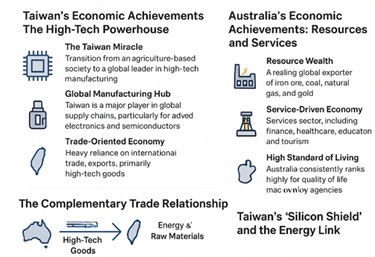
The economies of Taiwan and Australia, while both classified as advanced high-income economies, are distinct due to significant differences in their factor endowments, leading to highly complementary trade and economic achievements. Taiwan’s economy is characterized by its focus on high-technology manufacturing, whereas Australia’s is strongly driven by natural resources and services.
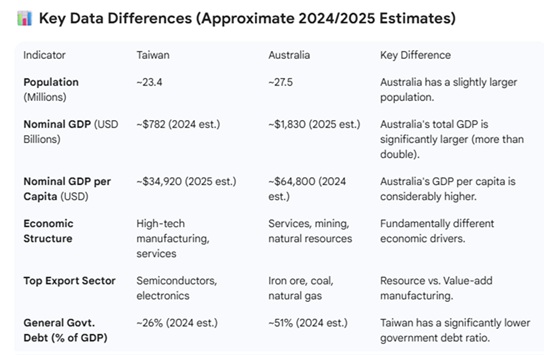
Taiwan’s Economic Achievements: The High-Tech Powerhouse
- Taiwan’s economic achievement, often referred to as the “Taiwan Miracle,” is a transition from an agriculture-based society to a global leader in high-technology manufacturing, despite its small land area and scarce natural resources.
- Global Manufacturing Hub: Taiwan is a major player in global supply chains, particularly for advanced electronics and semiconductors. It produces the vast majority of the world’s most advanced semiconductors, with companies like TSMC (Taiwan Semiconductor Manufacturing Company) being critical to the global tech industry.
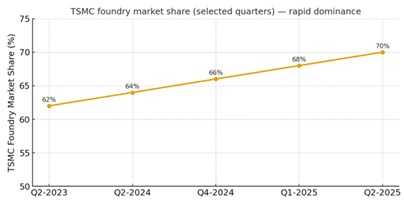
Source: TrendForce
- High GDP Per Capita: While having a smaller overall GDP than Australia, Taiwan’s intensive, value-added economy supports a high nominal GDP per capita, placing it among the top advanced economies globally, surpassing several other developed nations in the region.
- Trade-Oriented: The economy is highly dependent on international trade, with exports—primarily high-tech goods—being the main engine of growth.
- Fiscal Strength: Taiwan maintains a relatively low level of public debt as a percentage of GDP, indicating strong fiscal health.
Australia’s Economic Achievements: Resources and Services
- Australia’s economic success is built on its vast land area, rich natural resource endowments, and robust services sector, providing a high standard of living.
- Resource Wealth: As we well know, Australia is a leading global exporter of iron ore, coal, natural gas and gold. The mining sector and associated commodities play a vital role in generating export revenue and driving national income.
- Service-Driven Economy: The largest sector is services, including finance, health care, education and tourism. This broad base has helped Australia maintain a record of continuous economic growth for nearly three decades leading up to the COVID-19 pandemic.
- High Living Standards: Australia ranks highly for its quality of life, benefiting from a high nominal GDP per capita, a strong welfare state, and high average incomes.
- Stable Growth: The country’s economy is generally seen as stable, with a strong regulatory framework and a AAA credit rating from major agencies.
Comparative Analysis
- The key differences highlight the complementary nature of the two economies, which underpins their bilateral trade relationship:
- Economic Foundation: Taiwan’s economy is built on human capital, innovation, and value-added manufacturing (e.g. silicon chips), while Australia’s is founded on natural resources and its services sector.
- Trade Focus: Australia exports raw materials and energy (coal, iron ore, gas) to Taiwan, which in turn exports finished and intermediate high-tech products (refined petroleum, telecom equipment, computers) to Australia.
- Scale vs. Intensity: Australia has a larger overall economy (higher nominal GDP) due to its size and resources, but Taiwan’s high-tech specialization yields an economic intensity that rivals much larger nations.
- Fiscal Management: Taiwan has managed to maintain a significantly lower government debt-to-GDP ratio compared to Australia and most other advanced economies.
The Complementary Trade Relationship
The trade flow is a classic example of a developed-to-developed trade relationship where one side specializes in resources and the other in manufacturing and high-tech: Australia is a reliable supplier of energy and raw materials required by Taiwan’s vast industrial base, and Taiwan is a major supplier of finished and intermediate high-technology goods that are essential for Australian consumers and businesses.

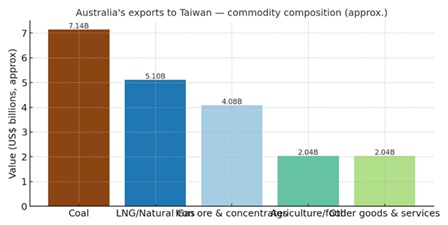
Taiwan’s Exports to Australia (Technology-Driven)
Taiwan’s exports to Australia centre on manufactured goods, reflecting its strength as a global industrial and technological hub:

Taiwan’s Export Composition
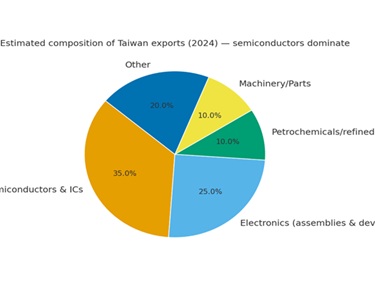
Source: Source: Taiwan BOE
Key Economic Implications
Trade Balance: The trade relationship typically results in a significant trade surplus for Australia in goods, due to the high value of Australian energy and resource exports.
Energy Security: For Taiwan, Australia is a vital partner for energy security, a strategic priority given its reliance on imports and regional geopolitical context.
Diversification: For Australia, the trade relationship with Taiwan provides a high-value complementary market for its resources, helping diversify its export risk across the Asian region.
Future Opportunities: Both countries see opportunities for deeper cooperation in green energy, biomedicine, and advanced manufacturing.
Taiwan’s “Silicon Shield” and the Energy Link
Taiwan’s dominance in the semiconductor industry is so profound that it has been termed its “Silicon Shield”—the idea that the world’s dependence on its chips deters any military action that would cripple the global economy.
Global Chip Dominance: TSMC is the world’s largest contract chip manufacturer, producing over 90% of the world’s most advanced chips used in everything from iPhones and advanced servers to critical military hardware.
Economic Impact: The semiconductor industry accounts for a substantial share of Taiwan’s total GDP (around 13-15%) and exports. Any disruption to this industry could lead to a global economic collapse costing trillions of dollars.
The Australian Energy Imperative
The connection to Australia lies in the incredibly energy-intensive nature of advanced chip manufacturing. Semiconductor fabrication plants operate 24/7 in ultra-clean environments and require massive, stable, and reliable power supply.
Massive Power Consumption: Companies like TSMC consume a significant portion of Taiwan’s total energy, with estimates around 6% for TSMC alone. The total demand for the industry is only growing as chips become more complex.
Taiwan’s Energy Scarcity: Taiwan has limited capacity for domestic energy production and relies on imports for nearly 90% of its electricity generation, making a stable supply chain critical for national security and economic output.
Australia as the Power Source: Australia is Taiwan’s largest supplier of imported energy.
Australia contributes around half of Taiwan’s imported coal and approximately 40% of its Liquefied Natural Gas (LNG).
This reliable supply of Australian fossil fuels effectively powers Taiwan’s high-tech industrial base and, by extension, sustains the Silicon Shield.
The Raw Materials Connection
While the energy link is the most direct and significant, Australia also holds strategic importance in supplying the raw materials that underpin the entire global tech supply chain, including:
- Silicon: The base material for semiconductors is silicon, derived from quartz. Australia has rich deposits of rock quartz, which is the starting point for producing the high-purity silicon used in chips. Australia is exploring ways to increase its domestic processing of this material.
- Critical Minerals: As chip technologies evolve (e.g. towards Silicon Carbide or Gallium Nitride chips for higher efficiency), the reliance on various critical minerals—some of which Australia is a major global producer of (e.g. lithium, copper, rare earth elements)—will only grow. These are crucial inputs for the broader electronic ecosystem and advanced components.
In essence, Australia provides the power and foundational materials that enable Taiwan to execute its highly specialized, world-dominant manufacturing and technological expertise.










